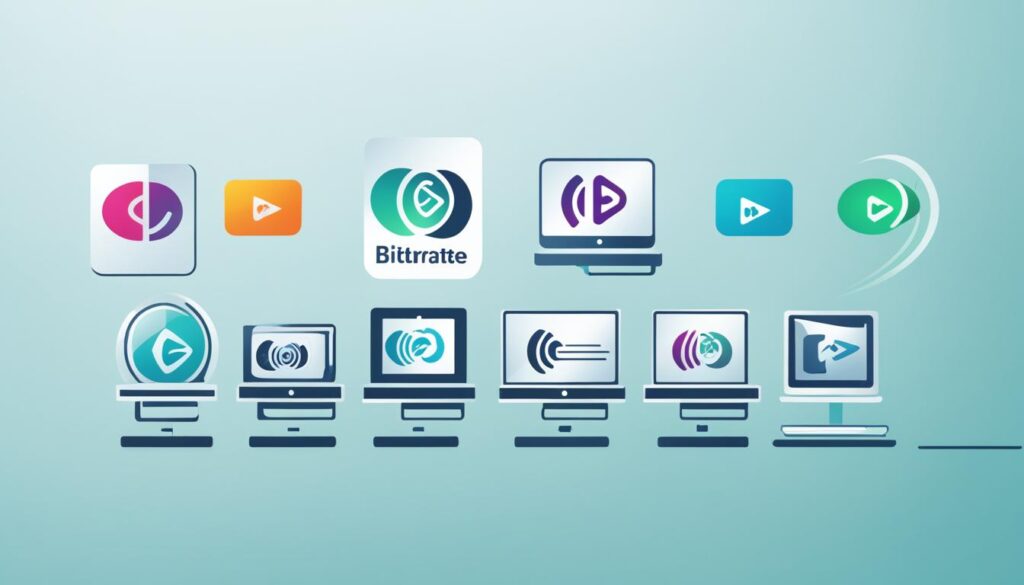Did you know that the global market for Internet Protocol Television (IPTV) is projected to reach a staggering $167.7 billion by 2025? With the increasing popularity of streaming services, enhancing IPTV quality of service has become a top priority for providers and subscribers alike.
IPTV offers a multitude of advantages, such as interactivity, personalization, and on-demand access to a vast array of content. However, optimizing the delivery of IPTV content over low-bandwidth networks can be a formidable challenge. To overcome these challenges and provide a seamless streaming experience, it is crucial to focus on bandwidth optimization and streaming optimization.
In this article, we will explore various strategies and techniques for enhancing IPTV quality of service. From choosing the right encoding format to implementing caching and edge computing, optimizing the network infrastructure, and configuring network devices, we will cover all the essential aspects of maximizing the performance and quality of IPTV streaming.
Key Takeaways:
- Optimizing IPTV quality of service is crucial in a market projected to reach $167.7 billion by 2025.
- Bandwidth optimization and streaming optimization are key factors in achieving a seamless streaming experience.
- Choosing the right encoding format and implementing adaptive bitrate streaming are essential for efficient content delivery.
- Utilizing caching and edge computing can reduce latency and bandwidth consumption.
- Optimizing the network infrastructure and configuration is necessary to handle IPTV traffic effectively.
Choosing the Right Encoding Format
The encoding format you choose for your IPTV content has a significant impact on its quality and performance. There are different encoding formats available, each with its own features and trade-offs:
- MPEG-2: Widely compatible but less efficient.
- MPEG-4: A more advanced format with improved efficiency.
- H.264: Widely used and balances quality and compatibility.
- HEVC: Excels in compressing 4K content but may not be supported by older devices.
To ensure the best viewing experience, it’s essential to choose the encoding format that suits your content type, target audience, and network conditions. Consider factors such as compatibility, efficiency, and support for specific resolutions or devices.
By selecting the right encoding format, you can optimize video compression and deliver high-quality IPTV content to your viewers.
For more information on how to enhance your IPTV service, refer to the next section: Utilizing Adaptive Bitrate Streaming.

Comparison of Encoding Formats
| Encoding Format | Compatibility | Efficiency | Supported Resolutions | Device Compatibility |
|---|---|---|---|---|
| MPEG-2 | Widely compatible | Less efficient | Up to 1080p | Most devices |
| MPEG-4 | Improved compatibility | Efficient | Up to 4K | Most devices |
| H.264 | High compatibility | Balance of quality and efficiency | Up to 4K | Most devices |
| HEVC | Limited compatibility | Highly efficient | Up to 8K | Newer devices |
Utilizing Adaptive Bitrate Streaming
Enhance the streaming experience for your IPTV viewers by implementing adaptive bitrate streaming (ABR) technology. ABR adjusts the video bitrate and resolution in real-time based on each viewer’s available bandwidth and device capabilities, ensuring optimal quality and avoiding buffering and pixelation.
ABR works by creating multiple versions of the same content with different bitrates and resolutions. As the viewer’s network conditions change, ABR seamlessly switches between these versions to deliver the best possible streaming experience.
Implementing ABR can be done using popular protocols like HLS (HTTP Live Streaming), DASH (Dynamic Adaptive Streaming over HTTP), and Smooth Streaming. These protocols enable the adaptive streaming function within your IPTV solution, allowing for intelligent bitrate and resolution adjustments.
By utilizing ABR, you can deliver high-quality video content to a wide range of devices and network conditions, ensuring a seamless and immersive viewing experience for your subscribers.

Benefits of Adaptive Bitrate Streaming:
- Improved viewing experience: ABR dynamically adjusts the video quality based on the viewer’s network conditions, preventing buffering and ensuring smooth playback.
- Optimized bandwidth utilization: By adapting the video bitrate, ABR minimizes bandwidth consumption without sacrificing quality.
- Device compatibility: ABR supports a wide range of devices, including smartphones, tablets, smart TVs, and computers.
- Streamlined content delivery: ABR reduces the need for multiple video versions by automatically delivering the most appropriate version to each viewer.
- Seamless transitions: Viewers can switch between different network conditions (e.g., from Wi-Fi to cellular) without interruptions or quality degradation.
Implementing adaptive bitrate streaming is crucial for providing a superior streaming experience to your IPTV audience. By incorporating ABR into your solution using protocols like HLS, DASH, or Smooth Streaming, you can ensure that your viewers enjoy smooth playback, optimal quality, and a hassle-free streaming experience.
Implementing Caching and Edge Computing
One of the key strategies for optimizing IPTV content delivery is implementing caching and edge computing. These techniques can significantly reduce latency and bandwidth consumption, leading to a seamless viewing experience for subscribers.
Caching: Caching involves storing frequently requested content on servers that are closer to the end-users. By caching popular content at the network edge, ISPs can improve response time and reduce the need for repeated requests to the origin server. This not only enhances the user experience but also frees up network resources, reducing bandwidth consumption. With caching in place, subscribers can enjoy faster content delivery and reduce the overall strain on network infrastructure.
Edge Computing: Edge computing takes advantage of the processing power and storage capacity available at the edge of the network. Instead of relying solely on central servers to handle all tasks, edge devices are used to perform computations and deliver content closer to the end-users. By moving content delivery and processing closer to the network edge, edge computing improves performance and scalability while minimizing network latency. This enables faster response times and reduces the amount of bandwidth consumed during content delivery.
By implementing caching and edge computing, IPTV providers can optimize content delivery and enhance overall service quality. Subscribers will experience reduced latency, faster content access, and improved bandwidth utilization. Additionally, ISPs can alleviate network congestion and lower bandwidth costs, resulting in a win-win situation for both providers and subscribers.
Benefits of Implementing Caching and Edge Computing
Implementing caching and edge computing offers several key benefits:
- Reduced latency: Caching and edge computing bring content closer to the end-users, resulting in faster response times and reduced latency.
- Improved bandwidth utilization: By caching popular content and performing processing at the network edge, ISPs can minimize bandwidth consumption, optimizing network resources.
- Enhanced user experience: Faster content delivery and reduced buffering lead to an enhanced viewing experience for subscribers.
- Scalability: Edge computing enables the distribution of processing tasks across multiple devices, improving scalability and handling increased demand.
By taking advantage of these strategies, IPTV providers can deliver high-quality, low-latency content while minimizing bandwidth consumption and maximizing network efficiency.

| Strategy | Key Features |
|---|---|
| Caching |
|
| Edge Computing |
|
Optimizing the Network Infrastructure and Configuration
When it comes to enhancing IPTV quality of service, optimizing the network infrastructure and configuration plays a vital role. It involves ensuring sufficient capacity, reliability, security, and quality of service (QoS) to handle IPTV traffic effectively. By monitoring network performance, analyzing usage patterns, and troubleshooting any issues or bottlenecks, you can proactively optimize content delivery for a seamless streaming experience.
To prioritize and optimize IPTV traffic, configuring network devices is crucial. Techniques like multicast, VPN, or SD-WAN technologies can be utilized to ensure efficient data transmission and prevent network congestion. These strategies enhance the overall performance and reliability of your IPTV service, allowing viewers to enjoy uninterrupted streaming of their favorite content.
Implementing network infrastructure and configuration optimizations can provide the following benefits:
- Maximize network capacity to handle high-bandwidth IPTV traffic.
- Ensure network reliability and stability for uninterrupted streaming.
- Enhance network security to protect against potential threats.
- Prioritize IPTV traffic for optimal quality of service.
Techniques for Optimizing Network Infrastructure:
Here are some techniques that can help enhance your network infrastructure for IPTV:
- Ensure sufficient bandwidth and network capacity to handle IPTV traffic load.
- Implement Quality of Service (QoS) policies to prioritize IPTV traffic over other network activities.
- Use multicast transmission to reduce bandwidth consumption and network congestion.
- Implement Virtual Private Network (VPN) solutions to secure IPTV traffic and protect it from unauthorized access.
- Consider Software-Defined Wide Area Network (SD-WAN) technologies to optimize network performance and ensure seamless streaming.
The table below summarizes the key aspects of optimizing network infrastructure and configuration:
| Aspect | Description |
|---|---|
| Capacity | Ensure sufficient network bandwidth to handle IPTV traffic load. |
| Reliability | Maintain network stability and minimize downtime for uninterrupted streaming. |
| Security | Implement measures to protect IPTV traffic from unauthorized access or risks. |
| QoS | Prioritize IPTV traffic and allocate resources to ensure optimal performance. |
By optimizing your network infrastructure and configuration, you can provide viewers with a high-quality IPTV experience, delivering content seamlessly and reliably.

Understanding IPTV Streaming and Network Requirements
For a seamless viewing experience with IPTV streaming, a robust home network is essential. To optimize network performance, it is crucial to understand the specific requirements for IPTV streaming, including bandwidth, internet speed, and latency.
IPTV services like Netflix, Hulu, Amazon Prime Video, and YouTube TV have recommended internet speeds for uninterrupted streaming. Determining your current internet speed and evaluating network latency are crucial steps in optimizing IPTV streaming.
Bandwidth
Bandwidth refers to the amount of data that can be transmitted over a network connection within a given timeframe. It directly impacts the quality of IPTV streaming, as higher bandwidth allows for smoother playback and higher resolution.
Assessing your internet plan’s bandwidth is vital to ensure it meets the requirements for uninterrupted IPTV streaming.
Internet Speed
Internet speed, measured in Mbps (megabits per second), determines how fast data can be transmitted to your devices. It affects the time taken to load and buffer IPTV content, directly influencing the user experience.
Most IPTV providers recommend internet speeds of at least 10 Mbps for standard definition (SD) streaming and 25 Mbps for high definition (HD) streaming.
Latency
Latency refers to the time it takes for data to travel from the source to the destination. It can impact real-time interactions and cause buffering or delays in IPTV streaming.
For an optimal viewing experience, it is advisable to keep network latency below 100 milliseconds.
| Streaming Quality | Minimum Required Internet Speed |
|---|---|
| Standard Definition (SD) | 10 Mbps |
| High Definition (HD) | 25 Mbps |
| 4K Ultra High Definition (UHD) | 50 Mbps or higher |
Ensuring your network meets the recommended requirements for IPTV streaming is essential for a seamless viewing experience. By understanding the importance of bandwidth, internet speed, and latency, you can optimize your network and enjoy uninterrupted IPTV streaming.
Upgrading Your Internet Connection and Router Considerations
When it comes to optimal IPTV streaming, upgrading your internet connection and choosing the right router are essential factors to consider. A reliable and high-speed internet service provider (ISP) can significantly enhance your streaming experience. Take the time to evaluate available internet plans based on your streaming needs to ensure smooth and uninterrupted playback of your favorite content.
Investing in a modern and capable router is equally important. A high-performance router can provide a stable and reliable internet connection, reducing buffering and latency issues. To further enhance network performance, consider implementing Wi-Fi optimization techniques. Selecting the right frequency, increasing signal strength, and minimizing interference are key strategies for improving your Wi-Fi experience.
Take a look at the table below for an overview of the key considerations when upgrading your internet connection and router:
| Considerations | Benefits |
|---|---|
| Choosing a reliable ISP | Ensures a high-speed and stable internet connection |
| Evaluating internet plans | Allows you to find the most suitable plan for your streaming needs |
| Investing in a modern router | Provides a stable and reliable internet connection |
| Implementing Wi-Fi optimization techniques | Enhances network performance and reduces interference |
By upgrading your internet connection and router, you can unlock the full potential of IPTV streaming, ensuring a seamless and immersive viewing experience. Don’t miss out on the next level of entertainment – upgrade your setup today!
Key Considerations for Upgrading Your Internet Connection and Router
Wired Network Optimization and Powerline Adapters
When it comes to optimizing network stability and streaming performance for IPTV, a wired network connection is the way to go. Using Ethernet instead of relying solely on Wi-Fi can provide a more stable and consistent connection, ensuring an uninterrupted streaming experience for your IPTV content.
Setting up a wired network at home is relatively straightforward. Connect your IPTV box or smart TV directly to your router using an Ethernet cable. This eliminates the potential interference and signal degradation that can occur with wireless connections, resulting in a more reliable streaming experience.

Powerline Adapters for Enhanced Network Stability
To further enhance network stability and extend a wired connection to other areas of your home without the need for additional wiring, consider utilizing powerline adapters. These innovative devices utilize your existing electrical wiring to transmit data signals, effectively turning your electrical outlets into additional network connection points.
Powerline adapters come in pairs, with one adapter connected to your router through an Ethernet cable and plugged into a power outlet near your router, while the other adapter is plugged into an outlet in the desired location where you need a wired connection. This provides a seamless and reliable wired connection, ensuring optimal streaming performance for your IPTV content throughout your home.
To ensure a smooth streaming experience and avoid buffering or interruptions, it’s important to choose powerline adapters that are compatible with your network speed and capable of handling the bandwidth requirements of your IPTV content. Consider adapters with gigabit Ethernet ports for maximum performance.
| Advantages of Wired Network and Powerline Adapters | Drawbacks of Wired Network and Powerline Adapters |
|---|---|
|
|
By optimizing your network with a wired connection and utilizing powerline adapters, you can ensure network stability and enhance streaming performance for your IPTV content. Say goodbye to buffering and enjoy a seamless streaming experience with Raw-Multimedia’s IPTV subscription services!
Security and Encryption for IPTV
Ensuring the security and encryption of IPTV is of utmost importance to safeguard content and subscribers from unauthorized access, interception, and piracy. By implementing robust security measures, IPTV service providers can protect valuable content and maintain the privacy of their network.
Encryption: Utilizing encryption techniques is crucial for securing IPTV content. Encryption algorithms encode the data transmitted between the IPTV server and the end-user device, making it unreadable to unauthorized parties. This ensures that only authorized users can access and view the content, minimizing the risk of piracy.
Authentication: Implementing authentication mechanisms adds an additional layer of security to the IPTV system. By requiring users to provide valid credentials, such as usernames and passwords, service providers can verify the identity of subscribers and prevent unauthorized usage.
Firewalls: Deploying firewalls helps protect the IPTV network from external threats and unauthorized access attempts. Firewalls analyze network traffic and enforce rules that filter out malicious activity, ensuring the integrity and privacy of the IPTV infrastructure.
Virtual Private Networks (VPNs): Using VPNs enhances the privacy and security of IPTV, especially when accessing content over public networks or overcoming geo-restrictions. VPNs encrypt users’ internet traffic and route it through a secure server, hiding their IP addresses and protecting their online activities.
Securing your home network is also essential to protect against potential threats. By securing Wi-Fi networks with strong passwords and configuring firewall and port forwarding settings, users can prevent unauthorized access and maintain network privacy. Compliance with legal requirements, such as copyright laws and licensing agreements, is crucial to ensure the legality and legitimacy of IPTV services.
Implementing comprehensive security and encryption measures not only protects content and subscribers but also builds trust and confidence among users. By prioritizing IPTV security, service providers can offer a secure and reliable streaming experience, creating a loyal customer base.
Monitoring and Troubleshooting for Optimal Performance
Ensuring a high-quality and reliable IPTV streaming service requires continuous monitoring and troubleshooting of network performance. By leveraging advanced tools like network analyzers, probes, logs, reports, alerts, and tests, providers can effectively measure network parameters, emulate subscriber experience, and identify and resolve any issues or faults that may affect IPTV quality.
Network analyzers are invaluable in monitoring network performance, allowing providers to gather data on bandwidth utilization, packet loss, latency, and other key metrics. This data provides insights into the health of the network, helping to identify bottlenecks, congestion, or other factors that may impact IPTV streaming quality.
Probes and logs can be used to collect detailed information about network traffic, allowing providers to analyze patterns, detect anomalies, and troubleshoot performance issues. By understanding network traffic behavior, providers can optimize network configuration, prioritize IPTV traffic, and ensure optimal delivery of content to subscribers.
Reports and alerts generated by monitoring systems provide real-time visibility into network performance, enabling proactive troubleshooting and issue resolution. For example, providers can set up alerts to notify them of sudden drops in network bandwidth or increases in packet loss, allowing them to respond quickly and minimize any impact on IPTV quality.
To gain further insights into IPTV streaming performance, providers can also conduct tests that simulate subscriber experience. These tests involve streaming content through the network and measuring metrics such as buffering time, video quality, and playback smoothness. The results help providers identify potential optimization areas and ensure a seamless viewing experience for their subscribers.
By regularly monitoring network performance and proactively troubleshooting any issues, IPTV providers can optimize quality of service, deliver consistent and reliable streaming, and ultimately provide an exceptional viewing experience for their subscribers.
Benefits of Monitoring and Troubleshooting for IPTV Providers:
- Enhance network performance and optimize bandwidth utilization
- Identify and resolve network issues that impact IPTV quality
- Proactively address potential bottlenecks and congestion
- Ensure consistent and reliable streaming for subscribers
- Optimize network configuration and prioritize IPTV traffic
- Improve customer satisfaction and reduce churn
With the right monitoring and troubleshooting strategies in place, IPTV providers can deliver a high-quality streaming service that meets the demands of their subscribers, providing them with an exceptional entertainment experience.
Conclusion
Optimizing IPTV quality of service requires careful consideration of various factors. By taking into account encoding format, adaptive bitrate streaming, caching and edge computing, network infrastructure and configuration, security and encryption, and monitoring and troubleshooting, IPTV providers can significantly enhance the viewers’ experience.
Implementing the right encoding format ensures efficient video compression and compatibility with different devices. Adaptive bitrate streaming dynamically adjusts the video quality based on available bandwidth, providing a seamless streaming experience. Caching and edge computing reduce latency and bandwidth consumption, improving content delivery.
Optimizing the network infrastructure and configuration ensures sufficient capacity, reliability, security, and quality of service. Upgrading internet connections, routers, or using wired networks enhances stability and performance. Employing security measures like encryption, authentication, and firewalls protects content and subscribers.
Monitoring and troubleshooting network performance and promptly addressing issues optimize the IPTV network. By implementing these optimization techniques, IPTV providers can maximize bandwidth utilization, improve streaming quality, and deliver an immersive and enjoyable viewing experience to subscribers. Unlock the endless possibilities of entertainment by subscribing to Raw-Multimedia’s IPTV services today, starting at just $11.99!



